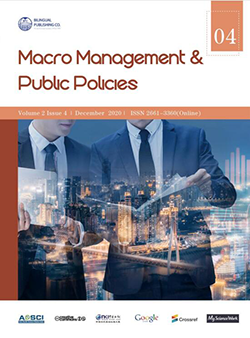-
897
-
367
-
274
-
259
-
256
Two Kinds of Analysis in the Issue of Dealing with EDPs
DOI:
https://doi.org/10.30564/mmpp.v2i4.2194Abstract
The settlement of EDPs [1] is one of the most knotty problems created by climate changes. In this paper, our team will give a comprehensive solution to tackle it. We construct two migration models to maximize the outcome of protecting the rights of EDPs and preserving their unique culture. Firstly, we talked about the reasons why we should protect the rights and culture of EDPs. We conclude that it is not only the spirit of UN, the morale responsibilities of every nation but also a good deed for human being which possibly can stop nationalism in each country from rising. I this process, we decide to use “carbon dioxide emission per capita” as standard to distribute responsibilities to different nations because it is more fair and efficient. Secondly, we start to build Migration Models. By using AHP, We quantify the important characteristics which will eventually make a big difference on the outcome of settlement. Then we get final results which indicate the most suitable countries for EDPs. Analyzing the results of Migration Models, we give policy recommendation at global and national level. For the first one, we suggest that UN should decide where EDPs’ be; when emergency happens or there are only few migrants, send them to the nearest countries to make sure of their safety and preservation of their cultures; and when it takes a long time to migrate and there are so many migrants, use Migration Model Two to decide because it needs to take the contribution to the world greenhouse effect, countries’ finance and preference of EDPs into consideration. Through the mathematic practice, we also find some factors, such as languages, population density and religious beliefs, can seriously affect the ultimate choice of the migration place so we recommend each nation positively take action to ensure EDPs can easily fit in. After that we bring time factors into our model. We use linear regression model to see the time when those island nations will be submerged. It indicates that UN should step in this issue as soon as possible otherwise it can be uncontrollable owing to the sinking islands and rising nationalism. At last, we list and compare three approaches to deciding where the home of EDPs should be. We conclude that only when UN in charge of this, it can make the best interest of both EDPs and different nations.Keywords:
Climate change; Refugee; Carbon emission; Distribution of responsibility among countries; Settlement of refugeeReferences
[1] JP Guo, GQ Shi. Environmental refugees or environmental migrants - A Review Of the Study on the Appellation and Definition of Environmental Migration at home and abroad[J]. Nanjing Journal of Social Sciences, 2010(11).
[2] G. Kibreab. Environmental Causes and Impact of Refugee Movements:a Critique of the Current Debate, Disasters, 1997(21), 30.
[3] Derek R. Bell. Envrionmental refugees: What rights? Which duties? Georgetown International Environmental Law Review. 2011, 138.
[4] UNHCR. Summary Of Deliberations On Climate Change And Displacement, International Journal of Refugee Law. 2011, 567.
[5] Neil Hodge. Global Environment: Acts or Emissions. International Bar Association Global Insight, 2012.
[6] Benoit Mayer. The International Legal Challenges Of Climate-induced Migration: Proposal for an International Legal Framework. Colorado Journal of International Environmental Law and Policy, 2011, 406
[7] HL Sun. A Legal thinking of the “Environmentally displaced persons”[J]. Legal Review of Nanjing University, 2011, 306.
Downloads
How to Cite
Issue
Article Type
License
Copyright © 2021 Author(s)

This is an open access article under the Creative Commons Attribution-NonCommercial 4.0 International (CC BY-NC 4.0) License.




 Qilin Wu
Qilin Wu

